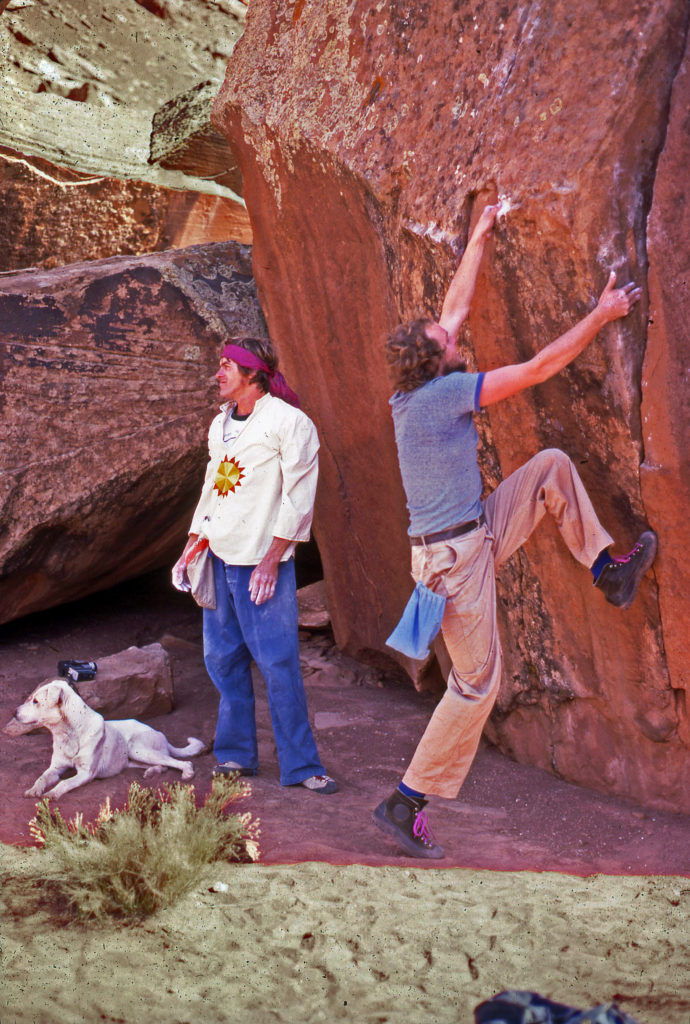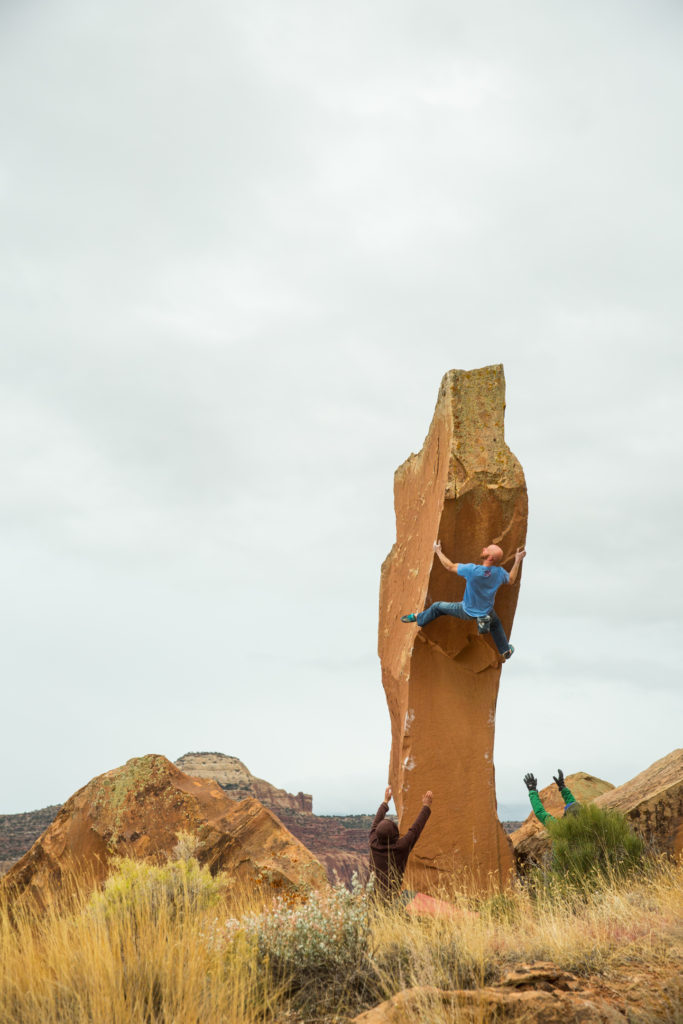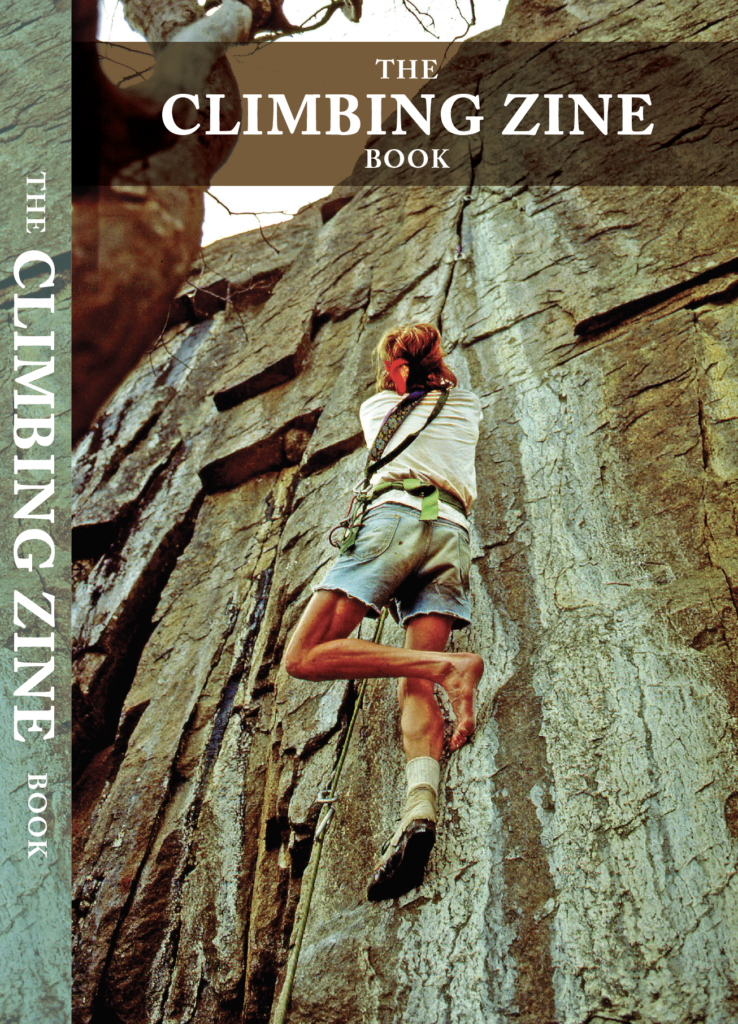November is closing in fast, and on this turn around the fireball, we reach a strange and interesting milestone in American rock climbing. Forty years ago, Earl Wiggins shouldered a rack of hexes and set out on the FA of a smooth and parallel-sided crack situated just up the hillside above a small cattle ranch in southeast Utah.
by Chris Schulte (note: this piece is published in The Climbing Zine Book.)
(Banner photo of the author on Boy With Apple. Photo: Chris Schulte collection)
A decided push, a scratchy bit of 8 mm footage, and Luxury Liner, aka Supercrack, was on line. In the following years, anchors would sprout high and low, spring-loaded camming devices would open the gates of the desert wide, and the Creek would burn sweet and dry on the palette with a juniper finish, hints of wood smoke and horseshit. Over a thousand lines would trace the weaknesses of the clean-cut cliffs, and still folks stream from the four corners of the globe to the Four Corners of the American Southwest for a taste of the coyote-and-roadrunner life, tape gloves, sandy burritos/butt cracks, and absolutely perfect splitters. After forty years of exploration and development, of stewardship and traffic, of grade-chasers and vision-questers, Indian Creek has become The Best Crack Climbing in the World.
In the hours leading up to that pivotal and visionary ascent, almost no mention is made of what that party of adventurers did with their time.
Deep breath, trad crusties: apparently, they went bouldering.
Let that out slow.
Camping just down the valley from Supercrack Buttress at the Fringe of Death Canyon, the merry band awoke, warmed, and stretched fiber and sinew on a collection of blocks that season the sage slopes and flats just outside of Canyonlands National Park. This stock of tilted roadside blocks is still an obvious attraction, with whispers of chalk beckoning. It’s the only place cited when I ask the springtime hordes that split the seams of the Donnelley parking lot if they’ve ever gone bouldering in the Creek. “Oh ya, we go, like, on a rest day, take a six pack…sometimes your gobies need a rest!”

Jimmie Dunn feeling the vibes and Stewart Green sampling some bouldering in the Fringe of Death Canyon, Indian Creek, circa 1976. Photo: Stewart Green collection
Somehow that morning’s motions, performed to calm the mind and lighten the spirits, went forgotten for decades, interred without ceremony beneath tangles of budding history, overshadowed by the ascent of a perfectly parallel crack once thought to be unprotectable. Oddly, today we say “visionary” and mean a splitter handcrack as obvious as a slap in the face, and not one of the subtle, balancey, powerful, flowing test pieces that enrich the valley floor. It was the question of protection that helped make the ascent of Supercrack so very visionary. In a time where American climbing was focused on Yosemite and still battled with the use of pitons as removable protection, one of the greatest concerns was whether the pro would hold in the soft Wingate. It was a bold, face-melting, determined lead, heavy with possibility and hexes and the whole of the future.
1976, and Indian Creek was new school as fuck.
Only two years later, cams changed the desert game, and folks flocked in to follow splitters to the sky while hawks wheel, and crows caw, cows moo, and the neck cranes upward. The pioneering crew of Wiggins, Webster, Becker, Green, Dunn, and Jackson carried on far beyond Supercrack, and new faces scribed their lines up leaner and longer splits. Hong. Porter. Savelli. Rodden. DeCaria. Bigwood. Leaner, longer, tougher cracks sprouted anchors on walls ever farther from the road, and plums ripened round the campfire and in sleepless nights were picked, sometimes sweet, sometimes sour. Kinda out of the blue, Steve Petro (“The potential for new routes is truly unlimited.”) lit a spark when he opened Let ’er Buck (5.12b) with Lisa Gnade and Gordon Douglass; I remember hearing the scandalous chatter that went about still, even a couple seasons later: “Someone’s definitely gonna chop it”; “this is a crack-climbing area.” I like to think that the route remains, on one hand, as a gesture of respect and, on the other, as a testament to the route’s quality. Nice intricate climbing, reads one Mountain Project comment. Some of the best arête climbing I have ever experienced, says another. Really, really fun, great change from tight handcracks…
So, what happened? There is an endless supply of cracks out in the Creek and an arête to pair with nearly every one. Nigh on twenty years passed after Luxury Liner before Let ’er Buck went in, and another decade before the next overt proposals blurred the implied lines of demarcation. Pat Savageau opened an extension to Swedin-Ringle (5.13R), dubbed Air Swedin, that carries on up the arête before rejoining the crack above for a hundred-foot pitch. Cedar Wright’s Half Man, Half Alligator Shark (5.13-) went in just a few feet down the line. With a span out a steep roof to a balancey arête sequence protected by fixed knifeblades, HMHAS was a bit of a bell, tolling out a reminder for some that this is a rock climbing area, after all. Hayden Kennedy upped the ante when he opened another Creek benchmark with questionable pro, the Carbondale Short Bus (5.14-). The trick is: you switch cracks. This is the technical crux; the redpoint crux comes with the sideways dyno at the top (again, where the crack stops), flying away from a pair of fretfully placed Black Diamond #000 C3s (the “Gray Ghosts”) toward a big, sloping jug on…the arête. Will Stanhope later added Down in Albion (5.13R), a wild and runout climb up an arête feature that links to Ruby’s Cafe, a heinous crack in its own right. The Creek was new school again, with the trappings of trad to maybe help you forget you’re arête and face climbing.

Chris Schulte, The Wolf AKA Air Wolf V?, Indian Creek, UT. Photo: Andrew Burr
I grew up skateboarding, you could say. New school was the word at the beginning of the ’90s: flip tricks, switch stance, huge pants, hip-hop. Old school was dropping boneless down the Biology stairs and railslides. That shit was had. Old school bro featured hair like Def Leppard and a leather motorcycle jacket. Wore shades indoors, holey jeans, and Chuck Taylors, smoked Reds and schwag. Smelled like Jack Daniels in class. But he was kinda cool, just a bit of a joke…his time was past, and in his revelries, he maybe just sounded a little funny, waxing on in what was likely a refined appraisal of the finest highlights of yesteryear. We’d giggle and humor this remnant, sifting through the bullshit for some occasional pearl of great value, some timeless ethic they’d impart through the smoke.
And yet, just a few turns around the sun can bring even dinosaurs back to life, and suddenly, anything can be cool again, if the timing and the proper analogous placement are considered. Old school became cool. Serpico. Cowboys, Pall Mall clubs with leather and libraries. Funny thing is, nowadays old school stays cool. Grandpa’s hat, loungey jazz, and martinis. Old school came also to mean tougher, rougher. Mobsters. Spies. Cedarwood dove-handled short-barreled Peacemakers. Or, V neck sweaters and pilot shades. Vespas. Pirates. Pool halls. Those 1950s 5.8+ offwidths that were easier in boots became hard in modern climbing shoes and easier in approach shoes again. Kids rock hair with sides shaved cuz dudes in WWII movies look cool. We did too, around 1985, but I think it was because of Depeche Mode, who probably resurrected it from WWII-era photographs or Andy Warhol.
The usage of style is a social tool, a language. Style in climbing is an act often indistinguishable in any way other than through the imagination: e.g., toproping vs. soloing. It can mean taking a pause from evolution and progress, a step back from forward motion when moving forward begins to mean moving for the sake of moving on. Style often means looking back and appreciating the roots in a new light. The traveled city kid comes home to the farm just dying for Momma’s cooking, though sometimes Mom’s cooking sucks. Mom Shorts aren’t cool, and neither is Dad Bod. Some people shouldn’t have handlebar moustaches. Fixies are kind of unpleasant to ride. We recombine, refit, refine, like Mr./Mrs. Potatohead, looking for the essence of whatever it is we’re looking for that’s us. Old and new school are an interchangeable process, which tells us everything about the guts of a trend, and our guts…I wander…point is, nostalgia is the flavor of old school. It is often fortified with irony.
“Isn’t bouldering just practice for Real Climbing?” the bearded, taped, and Carhartt-armoured Real Climber once inquired, smiling and valiant behind his PBR shield. The crew laughs.
“Ah, sure?” I reply a bit sheepishly. “The bouldering scale starts at 5.10; what are you getting into today?” The crew laughs harder, and we head uphill to Coyne Crack. When I boulder up and down the first twenty feet in my approach shoes, a Real Climber declares he’s going bouldering this evening. The rest of the crew makes plans for tomorrow, mentioning a pint of whiskey.
Eh. Close.
Apropos of nothing, Splittervision is a malady that affects desert climbers after a while, making it impossible for them to see gigantic features or holds just a couple feet outside of the fissure before them. I suspect the defect can cause complications that can extend to other forms of climbing. It also works in reverse. I know of a V13 having been downgraded to about V9 when someone went ahead and used the lean locks at the back of the slopers.
I’ve bouldered in the Creek now for near twenty years. When I first arrived, riding shotgun before a trailer of dirt bikes and lugging a rack of singles, it was hard to believe that no one was out on those blocks. No one had cleaned and climbed any of the arêtes and faces. Rock was everywhere, and in most every way, the blocks were more solid and attractive than my home bouldering area. I’d never been to anything but what I’ll call Regular Climbing Areas, with sport and trad climbs side by side, even a boulder or two on the way in. Of course, I hadn’t been anywhere then…I thought all climbing areas were full-tilt, get-what-you-can Climbing Areas, where all disciplines and pursuits could be expressed. All the things had to be climbed, yes, “Because it’s there,” to quote Hillary, and “because the climbers are there,” to quote LeCarré. Hell, I’ve seen a crag with a practice rivet ladder, a boulder with a seam that folks would practice traversing tied-off knifeblades. I have to remind myself that that was in the halcyon years of absolute noobdom, where I still held that if someone was a climber, they must be a cool person, and we had lots in common. That climbing in the sun was a good idea. That I’d want to bring pitons to Yosemite. Soon enough, I learned that there were Big Wall areas, Ice Climbing areas, Sport Climbing areas, Bouldering areas, and Crack Climbing areas. “Indian Creek is a crack-climbing area,” a mentor explained to the untutored twenty-year-old me, confused, agape at wasted potential. It was like looking out over an orchard of ripe peaches rotting on the branch; his explanation was like my mother trying to explain faith to the six-year-old me: thin skin of substance, bones of dogma. Zero muscle. This is how it is, because it just is that way. The lure of sacrilege was too great: I headed out in the fields to go bouldering after three routes.
Intermittently I returned, always en route: a pause from the long strip of road between Colorado and the Buttermilks, a rest for skin worn thin and crimp-split by Joe’s Valley sandstone to the north, a dose of sun, and warmth, and dryness after a long winter in Font or the Front Range. I never had a lot of pads, never with enough gear to get back up onto the vertical jogging of the skyborne splits, never taking more than a day or two to sun up before returning to the mountains for the season opener or ender. I was a boulderer, exclusively, and for nearly fifteen years I was too bored with or scared of the things that the Creek had to offer on a rope, and too scared and lazy to assemble pads, drop ropes, clean up, and climb the stunning, ginormous boulders that are everywhere out there.
Years passed in this fashion until another midpoint stop after a winter trip to SLC. I’d told enough tales to spark some interest among Durango friends Mike Vice and Richie Hum to whet their appetites for sunny sandstone slopers and techy arêtes. Several seasons hence, and with the love and vision and turbo-overstoke of folks like Kyle O’Meara, Connor Griffith, Nate Davison, Wes Walker, and more, there are over 250 problems flung way up side canyons and over the plains and many, many more to find, clean, and climb. I’ve had to impose limits on myself for the boundaries of exploration: This is Indian Creek Bouldering. This is just more Random Desert Bouldering, ’cause wow: don’t worry; the desert is Big. Indian Creek is but a fraction of the wealth of the desert Southwest, if you like the stone.
Last winter, I spent 120 days in and around the Creek. Based nearby, I roamed mostly solo, climbing and exploring up and down the valley, in and out of the canyons, walking the ramparts and the gulches, feeling the flow. Eroding like the drainages. I found a rhythm, found myself at home, found myself comfortable. I found myself looking up at the cliffs. I began repeating boulders I’d opened, climbing slower, pausing for the imaginary clip, wondering how it would feel to climb V-blahblahblah after a length of splitter, or before, or by itself with a .75 Camalot waaay down around the corner. I visited far-out crags with little traffic; no one walks out this far, not with the hipness of the ol’ standbys and that newnew collection of hushhush cliffs the “locals” call secret, but you can see from the car. A while back, I put up my first anchors in the Creek, twenty years after my first visit, and TR’d the line with difficulty. This season, I tied in and did some 5.11s on the Cat Wall, kept it cool. Ennobled, I came back and sent the project: Moonlighting (5.12?), a left-facing fingers to tips in a black corner that peters out into edges and stemming before a wide lurp to a jug up top. It was my first trad FA in fifteen years. Wow, let me tell you: I was hooked on Indian Creek all over again.
You’ve heard that tired, old phrase about “taking the skills learned on the boulders/cliffs to the cliffs/big walls,” and it rings true here in the desert. Once again, the broad promise of the future is all around us, for the Creek has new runout routes that abandon the cracks and quest up grips and geometry. The Creek has 5.15 arêtes and 5.11 slabs. I confess, I went out looking for a sport climb to bolt, something perfect and in the backcountry where it could go unmolested and outside of scrutiny, laying up a stock of merit through reports from repeaters and so armoring it from the depredations of the uninformed and uninitiated zealot. I ended up finding one that fit the bill, and it ends up going on gear, which is just dandy. The Creek still provides, and that lifetime of crack climbing is now paired with another lifetime of arêtes, maybe another of faces. The finds are getting harder, weirder, scarier. Gritstone-style headpoints and multi-pitch tradventures to the rim. My kettle of bouldering projects simmers on the back burner where I can throw in the occasional dash of spice or hunk of meat. I scan cliffs now, looking for hanging blocks and seams offset just enough. I scroll through a bank of project pics on my phone on cool Colorado nights, zooming and scrolling, wondering if the yellow X4 would go in that seam, feeling like all the climbing I do now is just keeping busy ’til the desert chills out.
Eek.
Bouldering has become Practice Climbing for me. In the words of Darth Vader, “The circle is now complete.” Maybe soon it’ll be new school to be well rounded, even out here. Which is, of course, old school as fuck.
Chris Schulte has been on a weird vision quest for over twenty years, one of those where you’re not sure if you’re on the right track, but then suddenly it’s wide and easy and opens up to one hell of a view.









Hi Chris,
My partner and i are looking to do some easy boulders in Indian creek next week, any suggestions or guidance would be great! Thanks!
We are v4-v5 tops newbies!
Reminds me of conversations I had with my father and grandfather when I was young. I was born in 1951, my fathers spoke tome about the lechuguilla plant and how it’s fibers were used to make ropes, bags, slings, sacks to carry corn etc. this all was precolumbian tech used well into the 1960s. How incredible what our people accomplished from the use of a simple plant.